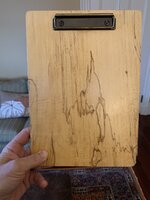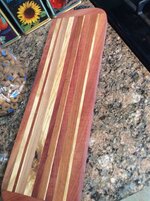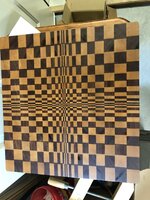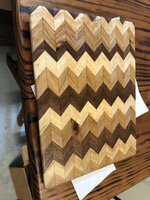JonathanF1968
Member
Happy new year everyone! I hope you are all staying safe and healthy.
I'm thinking about making cutting boards, per personal use, and have some questions.
I've mostly seen them created with strips of different wood types, or from blocks with the end grain showing on the surface. Are these different approaches functional, related to warping etc., or are they purely aesthetic?
I have some wide planks of spalted maple that I'm looking for projects for. Some are over a foot wide. Wondering if I could just simply cut them to size and finish them, preserving the natural spalting patterns, or if that's going to lead to a board that doesn't last long or serve the chef (i.e., my wife) well, in the kitchen.
I've attached a photo of a clipboard I made from this wood, which I created as a kind of test to see what the wood looks like when made into something. (I use it all the time.) Great test, I forgot what I used to finish it (and am not thrilled with the result, but it's good enough to know that I like this wood enough to continue with it. It's been maybe six months and this clipboard has stayed true, but the wear and tear and blood/guts/water/knives/heat/mayhem/etc. of a cutting board is a different story.
--Jonathan
I'm thinking about making cutting boards, per personal use, and have some questions.
I've mostly seen them created with strips of different wood types, or from blocks with the end grain showing on the surface. Are these different approaches functional, related to warping etc., or are they purely aesthetic?
I have some wide planks of spalted maple that I'm looking for projects for. Some are over a foot wide. Wondering if I could just simply cut them to size and finish them, preserving the natural spalting patterns, or if that's going to lead to a board that doesn't last long or serve the chef (i.e., my wife) well, in the kitchen.
I've attached a photo of a clipboard I made from this wood, which I created as a kind of test to see what the wood looks like when made into something. (I use it all the time.) Great test, I forgot what I used to finish it (and am not thrilled with the result, but it's good enough to know that I like this wood enough to continue with it. It's been maybe six months and this clipboard has stayed true, but the wear and tear and blood/guts/water/knives/heat/mayhem/etc. of a cutting board is a different story.
--Jonathan




